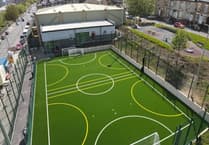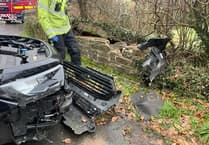THE future of Winsford Cottage Hospital in Halwill Junction has been secured thanks to historic buildings charity the Landmark Trust.
The Trust has raised £1.5-million to secure the future of the Grade II listed cottage hospital building.
Building contractor J E Stacey, based in Holsworthy, nine miles from the building, has been appointed to carry out work to conserve everything possible and return the whole building to its pre-1914 state with minimal adaptation or intervention.
The bulk of the funds was donated by 1,373 of the charity’s supporters and grant-giving trusts combined with gifts in wills and a surplus from the charity’s operations, equating to £876,000. An additional £487,000 of National Lottery funding from the Heritage Lottery Fund (HLF) was then given on top of an earlier development grant of £96,000 and a further £23,000, from the Andrew Lloyd Webber Foundation, closed the remainder.
Designed in 1899, the building is a unique example of an unaltered cottage hospital and the only such hospital designed by pioneering arts and crafts architect Charles F A Voysey. The Landmark Trust, which saves remarkable buildings at risk and transforms them into holiday accommodation, launched a £1.5-million appeal in June 2017, and the money raised will enable the full repair and restoration of this significant building and create a new, self-catering property, bringing tourists to the area and creating local employment.
Anna Keay, director of the Landmark Trust, said: “In 1898 enlightened philanthropist Maria Medley gave Winsford Cottage Hospital to her local community in order to transform the quality of their medical care. 120 years later the generosity of Landmark’s supporters alongside National Lottery players will secure the survival of this outstanding building. Some historic buildings are architecturally important and some have changed people’s lives. Winsford Cottage Hospital is rare example of a structure which is genuinely both.”
The project will unlock a wider programme of transformation through craft skills training, including at least two craft apprentices studying for an NVQ Level 3 in Heritage Skills plus City and Guilds and Furniture Making and Design students at Bridgewater College. There will also be volunteering opportunities and community activities, with the former accident ward available for hire by community groups, local businesses or home-workers. Referencing the building’s original purpose, there will be a dedicated treatment room for a local healthcare professional and NHS prescriptions will be collected from the hospital.
2018 marks seventy years since the creation of the National Health Service, and the completion of this fundraising appeal highlights the reality of healthcare provision before 1948. Cottage hospitals had brought radical change to rural healthcare in the late 19th and early 20th centuries by allowing ordinary people to be cared for in their own communities. Many babies were born and thousands of patients, including hundreds of convalescing World War One soldiers, were treated in the now dangerously dilapidated hospital.
Caroline Stanford, the Landmark Trust historian, is embarking on in-depth research and hopes that people who know of the hospital will share their stories.
Despite a vigorous local campaign to keep the hospital open it was closed by the North and East Devon Health Authority in 1998. A small local trust was founded to keep the building in community use but the task proved too great. It has been on Historic England’s ‘Heritage at Risk’ register since 2009 despite being ranked in the top 6% of all listed structures for architectural importance.
Winsford Cottage Hospital epitomises Voysey’s work, who pioneered a style rooted in fine local materials and exceptional craftsmanship. Voysey was best known for his country houses and Winsford was his only cottage hospital. The survival of Voysey’s fittings and fixtures — such as the mosaic floor, fireplaces and metalwork — with relatively little loss is remarkable, including his beautiful yet understated details of hearts, birds and trees.
Nerys Watts, head of HLF South West, said: “Thanks to National Lottery players, this historically significant and special building will be brought back to life and given an exciting and sustainable future. As well as saving a part of Devon’s heritage, this project will provide a boost for the local economy and tourism and provide valuable opportunities and community space.”



Comments
This article has no comments yet. Be the first to leave a comment.